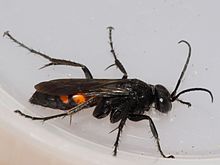| Anoplius viaticus | |
|---|---|

| |
| Scientific classification | |
| Domain: | Eukaryota |
| Kingdom: | Animalia |
| Phylum: | Arthropoda |
| Class: | Insecta |
| Order: | Hymenoptera |
| Family: | Pompilidae |
| Genus: | Anoplius |
| Species: | A. viaticus |
| Binomial name | |
| Anoplius viaticus (Linnaeus, 1758) | |
| Synonyms | |
| |
Anoplius viaticus, commonly known as the black-banded spider wasp, is a species of spider wasp. These wasps are known as spider wasps because the females capture spiders to provide their offspring with food. The paralysed spider is cached in a burrow, the wasp lays an egg on it, and when this hatches, the developing wasp larva consumes the spider. This species is found in sandy heathland across most of Europe.
Description
A. viaticus is a large species of spider-hunting wasp and measures about 14 millimetres (0.55 in) in length. The head and thorax are black and the propodeum is fused to the thorax and bears erect black hairs. The first three terga of the abdomen are red with black rear margins and the remainder of the abdomen is black.
Diet
Adult A. viaticus feed on nectar from flowers. Wasps in this species predominantly prey on spiders from the wolf spider family Lycosidae, but they also take ground spiders (Gnaphosidae), grass spiders (Agelenidae), crab spiders (Thomisidae) and jumping spiders (Salticidae).

Biology
Anoplius viaticus is unusual in that it overwinters as an adult, hibernating in a deep burrow. This enables it to emerge and become active earlier in the year than other related species. In southern England, it is on the wing from March onwards.
The female A. viaticus searches for a suitable spider with which to provision its nest. The spider is injected with venom to paralyse it and is dragged back to the chosen nesting location. The wasp puts the spider down and digs a shallow burrow. The spider is then dragged into the burrow, the wasp lays an egg on its still-living body and plugs the burrow with soil. Further similar single cell nests are excavated and provisioned, usually in close proximity to the first.
Things do not always go according to plan. Other female wasps may try to steal the prey before it is brought to the nest site, or they may take it while the nest is being excavated. Wasps have been observed to deposit their paralysed prey in grassy areas, where it is perhaps less visible to conspecifics, while the nest burrow is dug. Even after the burrow is sealed, it is not entirely safe, as other wasps may try to unseal it and lay their eggs on the prey, a practice known as brood parasitism. Female wasps defend their nesting site and drive away conspecifics that come too close. They seem to be concerned for the safety of their future offspring because they frequently interrupt their hunting to return to the nest site, and the clustering of the burrows makes their defence easier.
References
- ^ Wahis, Raymond. "Anoplius (Arachnophroctonus) viaticus (Linnaeus, 1758)". Fauna Europaea. PESI. Archived from the original on March 4, 2016. Retrieved 2015-06-17.
- "Spider wasps". BBC Nature. 2014-10-01. Retrieved 2015-06-23.
- ^ Early, Jeremy. "Anoplius viaticus". Nature Conservancy Imaging. Retrieved 2015-06-17.
- Day, Michael Charles. Handbooks for the Identification of British Insects. Royal Entomological Society of London. p. 35.
- Davidson, A.S. "Anoplius viaticus (Linnaeus,1758)". Bees, Wasps and Ants Recording Society. Retrieved 2015-06-19.
- ^ Field, Jeremy (1992). "Intraspecific parasitism and nest defence in the solitary pompilid wasp Anoplius viaticus (Hymenoptera: Pompilidae)". Journal of Zoology. 228 (2): 341–350. doi:10.1111/j.1469-7998.1992.tb04613.x.
Further reading
- Günter, Roland. "Hard work for a single egg (Anoplius viaticus)". Naturbildarchiv Günter. Created: 2005. Updated: 2016. A series of photos showing Anoplius viaticus trapping a spider and fighting off other predators, in order to lay her egg.